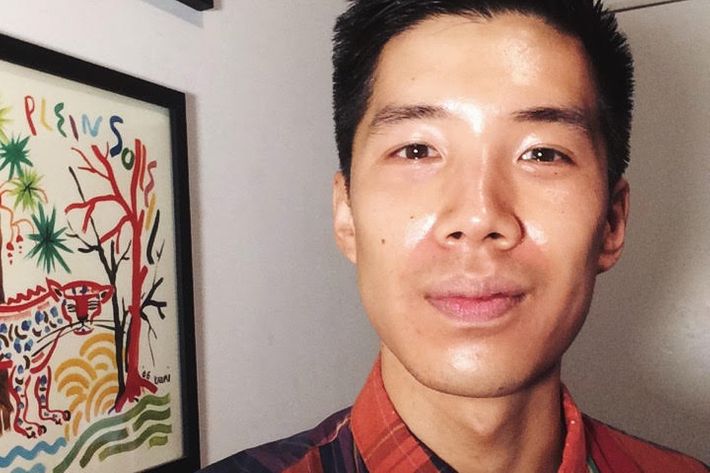
There’s something going on with the faces of South Korean men. Take a spin through Instagram, if you don’t know what I mean. Notice the moist cheek on one of K-pop’s biggest names, the dewy cheekbones on the country’s drama stars, the shiny forehead on the financier Insta-hunk. Yes, their faces are too wet and smooth, but it’s not the look of H2O — there’s a gelatinous quality to that shine, like the pearlescent glaze that coats the strawberries on a fruit tart. With a little bit of research, I found the likely secret behind those lustrous, polished faces, and it ain’t Photoshop.
As with zit concealer and dry shampoo before it, the glowing trend that men are now adopting began with women. Read any beauty blog, and you’ll notice that Korean women (and now American ones, too) have already added any number of beauty steps to get that lit-from-within look. There’s even a name for the idea, mul-gwang, which translates to mean “liquid radiance” (the literal words mean “water light”). The goal is to create a radiant, cherubic, un-made-up face — the kind you can only achieve, of course, with the help of makeup.
When the mul-gwang look crossed over for men is arguable, but a seminal moment occurred with the drama series My Love From the Star at the end of 2013, says Christine Chang, co-founder of Korean skin-care e-commerce website Glow Recipe. The series depicted an alien who, having landed on Earth 400 years ago, falls in love with a present-day actress. Over its 21 episodes, Star drew bonanza ratings not just in South Korea, but across the rest of Asia as well — and established lead actor Kim Soo-hyun’s fresh-faced visage as a paradigm for Korean men.
The objective is not simply a wet-looking face. Sure, the area around the cheeks and brow bones should catch the light, but more in a “I just emerged from the womb” way than an “I just ran a 10K” way. “The idea is textural,” Chang says. “There’s this expression for the kind of skin you’re looking for, which is a bit complicated, but roughly means ‘mochi skin’” — named for the Japanese rice cake — “which has that plump and supple consistency. It’s almost like if you were to flick it with your finger, it would bounce back.” Obviously, mochi skin’s a foreign concept to American men, for whom dewy is just one half-step away from greasy. I say this as someone whose medicine cabinet right now is stocked with various shine-control, mattefying, and oil-eliminating potions, and who has publicly commented on the matte for men trend.
The dull, shineless look feels very 2010, however, while the aesthetic of trend-obsessed Korean men — standing as it does at the intersection of Asia’s ascendancy as a cultural influencer, the gender fluidity of beauty ideals, and its rapid-fire visual communication through social media — feels extremely 2016. I’m ready to be converted. Chang recommends a one-step solution: the soy-milk bio lumpoule by Primary Raw (“lumpoule” is a portmanteau of luminous and ampoule), a gel that contains fermented soy to highlight and hydrate the face. Following Chang’s excellent instructions, I applied the stuff early in the day and tapped it into my face. Rather than feel gluey or thick the way I expected it to, the gel — sorry, lumpoule — actually disappeared immediately, leaving my face with just a hint of brightness, especially around the “T-zone” (the term cosmetics companies use denoting the forehead, the nose, and the area around the mouth). More than that, the skin felt smoothed away, like I’d taken the world’s gentlest pumice and cleared all the debris off my face, without any of the abrasion of an exfoliator.
Over the course of the day, I found my gaze drawn to reflective surfaces — I couldn’t stop looking at my poreless, radiant, and, yes, dewy face. When I coyly asked my friends whether they noticed anything different about my skin, though, most of them demurred. “I mean, now that you mention it, your forehead and nose are catching the light a little bit,” one friend said. “Oh, I thought it was just because you came in from the rain,” said another. “I didn’t notice any moistness, but you’re looking very cheekbone-y,” said my boyfriend (beside the point, but I’ll take it). Initially, I couldn’t help being disappointed in the failed experiment. After all, what’s the point of a mini-makeover that no one notices? The more I thought about it, though, the more I became convinced that stealth improvement was what I was actually going for, the way that good Botox doesn’t look like anything but “well-rested.” I was thrilled to have found a new daily moisturizer, and in the interest of documentation, I took a picture — in which I looked (oh, God) as sopping and greasy as the Korean thirst traps I follow on Instagram. Could it be that the mul-gwang look is the Steve Carell of grooming trends: better-looking in person than in pictures?

“In photos, it’s definitely a little confusing,” Chang says. “In real life, you get the sense of hydration and suppleness. When you look at a person who’s got this face, his skin quality just looks a little more plump and attractive. That might not translate so well in photos.”
So, no, a Korean lumpoule is probably not the kind of moisturizer I’m going to be slapping on before attending a heavily photographed wedding or birthday party. I have a matte product for that. But I do know what I’ll be using on those lazy Sundays in the park when I want to look like a glistening preteen.